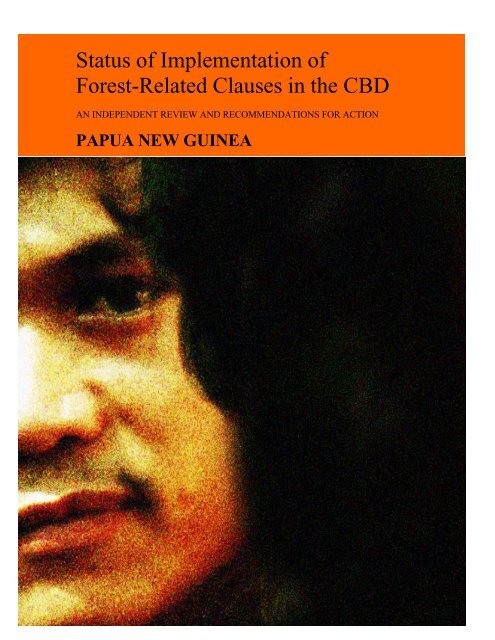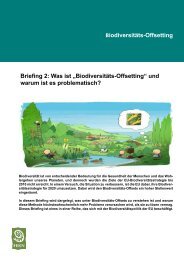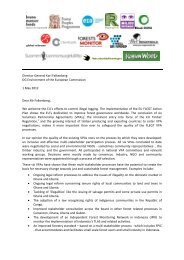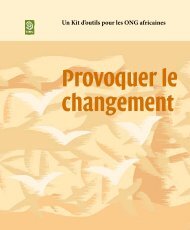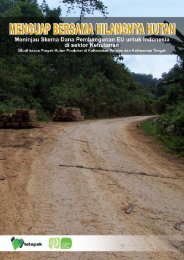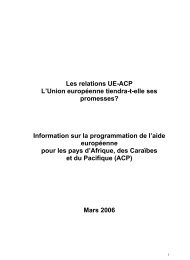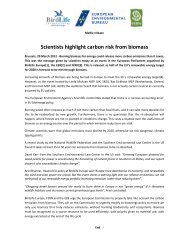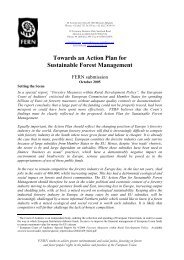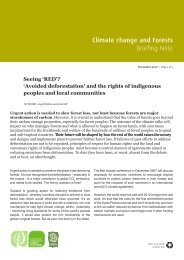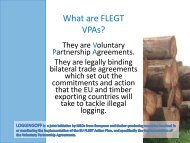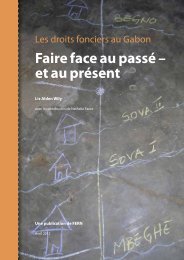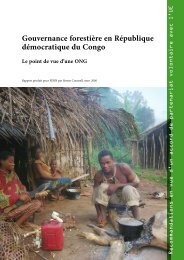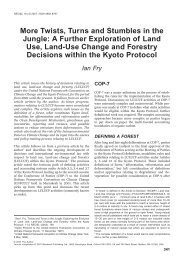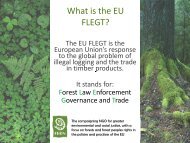Papua New Guinea - Fern
Papua New Guinea - Fern
Papua New Guinea - Fern
Create successful ePaper yourself
Turn your PDF publications into a flip-book with our unique Google optimized e-Paper software.
Status of Implementation of<br />
Forest-Related Clauses in the CBD<br />
AN INDEPENDENT REVIEW AND RECOMMENDATIONS FOR ACTION<br />
PAPUA NEW GUINEA
March 2002<br />
An analysis of <strong>Papua</strong> <strong>New</strong> <strong>Guinea</strong>’s Implementation<br />
of the Convention on Biological Diversity<br />
with a Focus on Forests<br />
Written by Glen Barry, Forests.org, Inc<br />
2
This report is part of a series of 21 country reports analysing the implementation of the<br />
CBD with a focus on forests. All country reports, as well as a synthesis report compiling<br />
and analysing the outcome of the 21 country reports, are available at www.fern.org. <strong>Fern</strong><br />
has been commissioned to co-ordinate and carry out this research by the Global Forest<br />
Coalition.<br />
<strong>Fern</strong> is a non-governmental organisation (NGO) that aims to improve European Union<br />
policies and practices in order to achieve conservation and sustainable management of<br />
forests and respect for the rights of forest peoples.<br />
The Global Forest Coalition (GFC) is a group of NGO’s and indigenous peoples<br />
organizations (IPO’s) that aim to facilitate the informed participation of NGO’s and<br />
IPO’s in intergovernmental processes relating to forests, such as the United Nations<br />
Forum on Forests (UNFF) and the Convention on Biological Diversity (CBD).<br />
<strong>Fern</strong> UK, 1C Fosseway Business Centre, Stratford Road, Moreton-in-Marsh,<br />
Gloucestershire, GL56 9NQ, UK email: info@fern.org<br />
3
Background Information<br />
The rainforests of <strong>Papua</strong> <strong>New</strong> <strong>Guinea</strong> (PNG) constitute one of the most significant remaining<br />
tropical rainforests on the Planet, in terms of both their tremendous biodiversity and critical<br />
global ecosystem functions. PNG’s rainforests are the largest intact tropical rainforest<br />
wilderness in the Asia Pacific region and the third largest on the planet. Some thirty-six million<br />
hectares, 77% of the total land area, are covered by closed natural forest. PNG's forests are<br />
among the most complex and species-rich terrestrial ecosystems in the world and contain an<br />
estimated 5-7% of the world’s total number of species.<br />
<strong>Papua</strong> <strong>New</strong> <strong>Guinea</strong> holds many records for diversity, including human cultural diversity. Over<br />
700 distinct languages are spoken - one quarter of the world's languages. PNG's rugged<br />
geography, with peaks over 13,000 feet high, offers a wide variety of microclimates, landforms<br />
and vegetative community types. Ten forest types are generally acknowledged, from highaltitude<br />
cloud and montane forests to lowland mixed forests and mangroves along the coast.<br />
PNG's forests provide habitat for around 200 species of mammals, 20,000 species of plants,<br />
1,500 species of trees and 750 species of birds, half of which are unique to the island. The<br />
world's largest butterfly (10.4-inch wingspan) and the world's largest mangrove expanses can be<br />
found in PNG.<br />
PNG’s citizens continue to rely heavily on their forests for their subsistence and economic wellbeing.<br />
These forests are vital to the livelihoods of the mostly rural population of over 4.5 million<br />
people - providing them with their food, shelter, medicines and their spiritual identity. There<br />
exists a strong attachment to the land, as some 97% of the country is under customary land<br />
tenure. Tribal clans living on their land thus have the final say regarding the fate of PNG’s<br />
forests and biodiversity. Foodstuffs and other materials from the forests and seas remain a<br />
central component of the <strong>Papua</strong> <strong>New</strong> <strong>Guinea</strong>n diet. There are an estimated 5,000 cultivars of<br />
sweet potato found within the country. Dozens of other native plant species have traditionally<br />
been, and continue to be, cultivated.<br />
Forest degradation and diminishment of biological resources is a serious problem in <strong>Papua</strong> <strong>New</strong><br />
<strong>Guinea</strong>. There is general agreement that the most significant threat currently posed to PNG’s<br />
biodiversity values stem from the degradation of terrestrial habitats by total or partial removal of<br />
natural forest cover. The country is currently experiencing a logging boom, as a large<br />
commercial timber industry is carrying out highly unsustainable resource extraction. The<br />
country is incurring high environmental and social costs from this industry.<br />
The present forest allocation process remains biased towards large-scale intensive management<br />
for log export by foreign companies. Almost half of the country's accessible forests are already<br />
committed to industrial logging, and dozens of proposed timber projects threaten the rest. It is<br />
estimated that 15 million hectares of forests could potentially be harvested for timber. At least<br />
two million hectares have already been logged. Annually at least 125,000 hectares (likely to be<br />
considerably higher) are selectively logged in an unsustainable and highly ecologically damaging<br />
manner. Many approved timber blocks have been placed in areas known to be high priority<br />
biodiversity areas. It is estimated shifting cultivation clears another 200,000 a year, although it is<br />
4
elieved only a small proportion of this is primary forest. Another 25,000 hectares of natural<br />
forest are deforested for agricultural, clearcutting and infrastructure construction.<br />
The Questionnaire and Overview of Status of CBD Commitments<br />
Given the importance of <strong>Papua</strong> <strong>New</strong> <strong>Guinea</strong>’s rainforests and biodiversity, it was important to<br />
include an analysis of the country’s progress in implementing commitments under the CBD in<br />
the broader analysis of progress worldwide. Identifying a suitable country monitor delayed the<br />
process somewhat. But once the ideal candidate was contracted, the questionnaire process began<br />
– albeit a bit later than the other countries surveyed. The questionnaire was given to the<br />
government and eight civil society organizations and individuals in mid-February.<br />
Three different approaches were made to the government; as questionnaires were sent to the<br />
country’s GEF focal point (the Secretary of the Department of Environment and Conservation),<br />
the Ambassador of the PNG embassy in the United States, and a representative of the Prime<br />
Minister’s office. No responses were received from the government. One non-governmental<br />
organization and two academics responded substantially to the questionnaire, a few others<br />
indicated that they did not have enough knowledge to answer the questions. Their responses,<br />
along with the considerable knowledge of the country monitor who has worked extensively in<br />
forest and biodiversity conservation policy in PNG, form the basis for this analysis. The lack of<br />
a governmental response is troubling; and is indicative of lack of capacity, and perhaps an<br />
unwillingness to comment on their lack of progress. We now turn to synopsizing the status of<br />
implementation of the Convention of Biodiversity in <strong>Papua</strong> <strong>New</strong> <strong>Guinea</strong>.<br />
PNG signed the Convention on Biological Diversity on June 13, 1992 and ratified it on March<br />
16, 1993. Shortly thereafter, given its history of involvement in forest management and<br />
environmental issues in PNG, the World Bank successfully lobbied to be named the GEF<br />
implementing agency with regard to conducting the Biodiversity Enabling Activities to<br />
formulate a National Biodiversity Strategy and Action Plan, and provide the conduit for<br />
financing from the GEF to carry out this work. From 1994 to 1998 essentially no progress was<br />
made by the government or the World Bank to implement the convention. Inexplicably, the<br />
World Bank simply forgot about its obligations, despite repeated attempts to remind them by the<br />
Department of Environment and Conservation and NGOs. The senior staff person responsible<br />
for the matter moved to a new position, and Bank management lost track of their obligation in<br />
this regard. In 1998, as the Bank was preparing a major new forestry operation, a Bank<br />
consultant (who happens to be the country monitor) became aware that the enabling activities<br />
had lagged. It was brought to the attention of senior Bank management that they were obliged to<br />
assist the PNG government, and formal enabling activities slowly began. This four year lag<br />
represents a critical missed opportunity to capitalize on other local initiatives in biodiversity<br />
conservation.<br />
During the hiatus civil society, with the help of other international organizations, conducted<br />
many of the stocktaking activities required under the convention. The <strong>Papua</strong> <strong>New</strong> <strong>Guinea</strong><br />
Country Study on Biological Diversity (Sekhran and Miller eds., 1994) was carried out with<br />
support from the United Nations Environment Program. The <strong>Papua</strong> <strong>New</strong> <strong>Guinea</strong> Conservation<br />
5
Needs Assessment Volume 1 (Alcorn 1993) and Volume 2 (Beehler 1993) sought to identify<br />
geographic areas of primary biodiversity importance and the Catalogue of Biodiversity Data<br />
Holdings for <strong>Papua</strong> <strong>New</strong> <strong>Guinea</strong> (Hedemark and Peters 1997), also with UNEP, systematically<br />
constructed a database regarding all known information concerning the biodiversity of PNG.<br />
These works are cited extensively in this report. In addition, a group of NGOs took it upon<br />
themselves to develop a Framework document as the basis for the coming strategy. Much work<br />
and effort went into developing a draft document that, while quite substantive, was never<br />
completed. These information gathering and planning processes nearly a decade ago have been<br />
of little significance. The reports have languished without resulting in development of the<br />
formalized National Biodiversity Strategy, much less in formal implementation of an Action<br />
Plan. They are rapidly becoming outdated.<br />
The World Bank has belatedly begun to assist the PNG government to carry out their<br />
Biodiversity Enabling Activities Project, a major step in the implementation of commitments<br />
under the Convention on Biological Diversity. A National Biodiversity Strategy and Action Plan<br />
is to be produced and the first national report submitted. Even after the Bank waited four years<br />
to acknowledge their obligations to serve as the conduit for GEF resources to PNG’s biodiversity<br />
planning efforts in 1998, things have still progressed extremely slowly. In 1998 some $182,000<br />
in GEF resources were acquired to finance these activities. Only in April of 2000 did the<br />
government committees and World Bank staff first meet to discuss the activity, and as of March<br />
2002 the contracting to actually start the project has only just begun.<br />
Nearly a decade of biodiversity loss has occurred in <strong>Papua</strong> <strong>New</strong> <strong>Guinea</strong> without the benefit of a<br />
National Biodiversity Strategy and Action Plan as the World Bank and government had more<br />
pressing business – both in economic and commercial forestry reforms. There were a number of<br />
reasons for this further delay. The World Bank and PNG government were at loggerheads<br />
during this period over a number of economic issues, which resulted in all interactions grinding<br />
to a halt – including things like biodiversity planning activities. There also arose disagreements<br />
regarding the use of the funds – the Bank insisted that the funds be used for bringing in expertise<br />
from civil society and consultants, while the government wished to use the money to pay<br />
government salaries.<br />
In summary, important CBD outputs necessary to move forward on biodiversity conservation in<br />
PNG have inexcusably been allowed to languish. The government of PNG has shown lack of<br />
commitment to implementing its obligation under the treaty. The World Bank is also largely at<br />
fault – having failed to fulfill their promise to help <strong>Papua</strong> <strong>New</strong> <strong>Guinea</strong> develop a biodiversity<br />
conservation strategy. Meanwhile, the World Bank and government of PNG are embarking on a<br />
major reform effort of the commercial logging industry which includes substantial GEF funding<br />
($US 17 million) – all without the benefit of a comprehensive biodiversity planning exercise and<br />
National Biodiversity Strategy and Action Plan.<br />
6
Questionnaire Results<br />
Reporting<br />
The PNG government has not submitted the national report on the implementation of the CBD or<br />
the thematic report on forest ecosystems to the CBD secretariat. Failure to develop these reports<br />
is indicative of lack of interest in biodiversity conservation by the government. It also<br />
demonstrates that in situ biodiversity conservation through protection of habitats is far less<br />
important to the World Bank than bolstering continued commercial forestry through another<br />
round of reform efforts and subsidies – an area where there has been feverish activity during the<br />
same period of no progress on the National Biodiversity Strategy and Action Plan.<br />
Implementation and Integration<br />
Formulation of the National Biodiversity Strategy and Action Plan process under the biodiversity<br />
enabling activities has been delayed for nearly a decade. Under the stalled enabling activities<br />
proposal that belatedly commenced in 1998, the First National Report and the PNG National<br />
Biodiversity Strategy were to have been published some three years ago, yet there is no sign of<br />
either. An in-country clearing house mechanism was to be established, of which there is no sign.<br />
A donor round table was to be convened as the NBSAP is finalized – to allow the government of<br />
PNG to present its priorities to the donor community. There are no indications that this has or<br />
will happen. There has still not been a completed strategy published. Despite having started<br />
some four years ago, only now has the process begun issuing a call for proposals for consultants.<br />
Efforts to date have been conducted in isolation from the broader conservation community<br />
outside the government, the World Bank and perhaps some international NGOs.<br />
The country monitor has no reason to believe that the IPF processes have been carried out.<br />
While there have been repeated forest planning exercises for the purpose of expanding industrial<br />
log exports, it is unlikely that an explicit National Forest Plan/Programme that conforms to IPF<br />
commitments has been completed. Forest planning gives short shrift to biodiversity. The<br />
national forest plans are primarily concerned with facilitating commercial scale logging of most<br />
of the nation’s rainforests. While some provisions are made for biodiversity conservation setasides,<br />
this is not the focus. Biodiversity planning is thus poorly integrated into forestry<br />
planning and vice versa. There is virtually no integration with other sectors such as agriculture,<br />
mining, oil and gas, etc.<br />
Negative Impacts on Biodiversity and Monitoring<br />
There have been a number of UN sponsored stocktaking exercises, as well as other reports which<br />
have clearly identified the threats to PNG’s biodiversity (references given previously). <strong>Papua</strong><br />
<strong>New</strong> <strong>Guinea</strong> carried out a country study on biological diversity in 1994 with assistance from<br />
UNEP that made preliminary investigations into factors negatively impacting biodiversity. Far<br />
and away the greatest threat was shown to be commercial scale logging by foreign companies for<br />
log export. Again and again industrial forestry has been shown to have devastating impacts on<br />
biodiversity, the environment, and the social fabric of the nation. But the government, World<br />
Bank and most donors adamantly refuse to consider options for biodiversity conservation which<br />
limit these activities. There has been reluctance to develop and implement national policies that<br />
support local efforts to carry out less damaging alternatives – such as community based small<br />
and medium scale use and protection of forest resources. There exists a well developed eco-<br />
7
forestry movement in a country which is continually thwarted by lack of government and donor<br />
support.<br />
Failure to reign in the logging industry threatens most biodiversity in the country. Other threats<br />
include clearing for development, slash-and-burn agriculture, oil palm development, which all<br />
exist at a much smaller scale than logging. Clearly the massive timber boom encompassing the<br />
country is a threat of a magnitude of its own. There is no rigorous and on-going monitoring<br />
program on these activities. This is mostly due to the low level of capabilities in the Department<br />
of Environment and Conservation – despite tens of millions of dollars of failed donor capacity<br />
building programs.<br />
Participation<br />
The proposal approved by the GEF, entitled “<strong>Papua</strong> <strong>New</strong> <strong>Guinea</strong> Enabling Activity Proposal in<br />
Biodiversity”, stated “The Biodiversity Strategy will be formulated through extensive<br />
consultation with stakeholders…” Most of those in civil society surveyed are completely<br />
unaware of the critical biodiversity planning activity that is soon to commence, much less are<br />
they participating. The proposal funded by the GEF stated there would be a series of national<br />
workshops to launch the consultative and participatory process, to set broad parameters and<br />
priorities, and to consider options for pursuit of biodiversity conservation. With the enabling<br />
activities about to commence, there is no indication that the groundwork of liaison and<br />
collaboration with civil society has been established. Large well-funded international NGOs<br />
have access to decision making processes; while the local groups doing the most innovative and<br />
important biodiversity and forest conservation initiatives are not contacted, not involved and are<br />
unaware of the CBD and its ongoing processes. There has been little coordination on the<br />
enabling activities with grassroots groups, much less local landowners.<br />
The rainforest and biodiversity conservation policy debate is largely dominated by reform efforts<br />
that seek to improve the performance of commercial forestry, and addresses biodiversity as an<br />
afterthought, and only as long as it does not threaten to limit the scope of industrial forestry. The<br />
development of a new World Bank Forestry and Conservation Project – which includes money to<br />
establish a trust fund to finance activities that conserves biodiversity – has been developed in<br />
virtual secrecy (particularly in the later stages when the project was radically changed). This<br />
trust fund would provide much needed financial support for landowners who wish to pursue<br />
biodiversity conservation based development alternatives. But the project fails to ensure that<br />
forest management alternatives, once established, will be free from continued pressures to pursue<br />
commercial logging. Currently, many ecologically sensitive alternative forest management<br />
projects fail because their status is not given legal recognition as a valid land use.<br />
There has been a gross failure to get broad-based participation in the process. This is because the<br />
government wants to use international funds for biodiversity conservation for their own<br />
purposes, such as government salaries, and the World Bank is pursuing its agenda of maintaining<br />
continued exports of raw logs. Those that question the assumption that better monitoring of<br />
industrial log exports is the best way to protect PNG’s biodiversity, and wish to foster a new<br />
paradigm of community based ecologically derived development and protection, are<br />
systematically excluded from deliberations and portrayed as villains. Biodiversity planning is<br />
being conducted by the government, World Bank and those that agree with their desire to<br />
8
maintain, accelerate and subsidize commercial scale logging of primary rainforests.<br />
Protected Areas, and Biodiversity Conservation<br />
The customary land tenure system whereby PNG’s tribal clans control their land communally<br />
presents tremendous opportunities to develop culturally appropriate conservation models.<br />
Landowners maintain final control over the use of the land. Clearly the Western national park<br />
model does not work under such a circumstance. If decisions by clans to pursue conservation<br />
were granted the same legitimacy as other land use decisions – such as logging or oil palm<br />
production – there would be the opportunity to construct extensive protected areas on the basis of<br />
many individual clan based conservation agreements.<br />
There has been a remarkable lack of imagination shown regarding how to use customary land<br />
tenure for the benefit of biodiversity conservation. The World Bank views the land system as an<br />
obstacle to economic development, and thus fails to support dynamic and innovative local<br />
initiatives to implement culturally appropriate protected areas. There are means to establish<br />
protected areas under PNG law. However, one type focuses primarily on wildlife and does not<br />
make provision for land-use planning and management guidelines; while the other provides more<br />
meaningful protections but is so difficult to implement that it has never been pursued. This<br />
global biodiversity treasure trove is in risk of having grossly inadequate strictly protected areas.<br />
There have been two major efforts to identify areas of relatively high biodiversity importance –<br />
the Conservation Needs Assessment and the BIORAP mapping exercise. Both were done mostly<br />
by international consultants and have not resulted in building lasting mapping and planning<br />
expertise in PNG. Once an area is identified as a priority in terms of biodiversity, there is no<br />
system in place to remove these areas from the pool of forests likely to be industrially harvested.<br />
The requirement that logging areas include conservation set asides is widely flaunted and usually<br />
targets lands that lack forest resources which are commercially viable. Even if done properly,<br />
these areas would not be large enough to maintain the full range of biodiversity and ecosystem<br />
values found in the now intact and contiguous rainforests.<br />
Indigenous Peoples’ Rights/ Customary Use and Local Support<br />
As noted previously, PNG’s forest owners have not been engaged in biodiversity planning to any<br />
meaningful extent. Rarely do international conservation planners set forth out of the capital,<br />
only occasionally making it to a provincial center, and rarely to a village or actual rainforest.<br />
Strengthening indigenous and local community’s participation in the National Biodiversity<br />
Strategy and Action Plan would require taking these proceedings out to remote villages where<br />
<strong>Papua</strong> <strong>New</strong> <strong>Guinea</strong>ns live. Those managing the World Bank’s program on the biodiversity<br />
enabling activities have little in-country experience and have little understanding of the needs,<br />
aspirations and feelings regarding biodiversity of PNG’s indigenous peoples. This dangerous<br />
lack of knowledge of the country by those facilitating implementation of the CBD virtually<br />
guarantees that another document is written that is removed from reality, rarely read, and does<br />
little to conserve biodiversity.<br />
The tremendous non-market benefits of forests to PNG citizens are not appreciated. The poverty<br />
associated with dispossessed ecological refugees – as occurs elsewhere - is confused with frugal,<br />
subsistence living of PNG’s citizens which, while materially lacking, meets most needs for food,<br />
9
shelter and other basic needs from the forests. The continued focus of government and donors<br />
on policing industrial forestry in order to limit its environmental impact fails to acknowledge<br />
other forest values – including both current subsistence uses and foregone opportunities to<br />
pursue ecologically based and sustainable community development.<br />
Threatened Species<br />
<strong>New</strong> environmental legislation has recently been enacted, but has not fully entered into force due<br />
to delays in writing regulations to implement the legislation. Given the millions of dollars<br />
invested in increasing capacity at the Department of Environment and Conservation, they remain<br />
amazingly without capacity. Over the last few years there has been little operational funds<br />
meaning little or no monitoring or fieldwork has been occurring. So, while there is legislation in<br />
place, it is not being implemented. This is not deemed a priority by the government. So little is<br />
known regarding patterns of biodiversity in PNG that only very few species benefit from such<br />
legislation. Even when protection is given, as with the Queen Alexandria Birdwing butterfly –<br />
the largest butterfly in the World, and is critically endangered – projects such as the World<br />
Bank’s Oro Oil Palm project are still allowed to destroy critical habitat – against PNG law and<br />
Bank policy. Threatened species are given no real protection in PNG.<br />
Incentives<br />
The recently approved GEF “Mama Graun” trust fund, part of the World Bank’s new Forestry<br />
and Conservation project, shows potential to provide the much needed funding source for those<br />
that wish to pursue biodiversity friendly development options. The problem is that there is still<br />
no legislation, or rules and regulations in place to ensure that such projects have legal standing<br />
and are not continually encroached upon. Many good alternative forest uses succumb to<br />
pressures to pursue commercial logging because there is no system of legal conservation status<br />
and enforcement.<br />
Environmental and Strategic Impact Assessments<br />
The new environmental legislation provides a well developed methodology that is beyond PNG’s<br />
capacity and is not adequately funded. Logging, mining, oil palm and other highly destructive<br />
development activities continue to occur with cursory or non-existent environmental<br />
assessments. When they do occur, they are viewed as a formality – not as a real review that may<br />
stop the biologically damaging project.<br />
Country Monitor Comments, Conclusion and Recommendations<br />
In the decade since ratification of the CBD by <strong>Papua</strong> <strong>New</strong> <strong>Guinea</strong>, not even rudimentary first<br />
steps have been taken to implement the convention. Meanwhile, a voracious timber industry<br />
threatens essentially all forest biodiversity in PNG and the continued existence of contiguous,<br />
intact, unfragmented habitats in which they are maintained. Low levels of governmental<br />
commitment to biodiversity conservation, and the World Bank’s failure to honor in a timely<br />
fashion their obligations to serve as the implementing agency, border on negligence and show<br />
bad faith. This report will now highlight several aspects of current biodiversity policy that are<br />
most troubling, and threaten to eliminate huge areas of biodiversity rich forest habitats before<br />
CBD processes such as a National Biodiversity Strategy and Action Plan are developed and<br />
implemented.<br />
10
Logging Boom Threatens Biodiversity and Ecosystems<br />
There has been a complete breakdown in forest sector management in <strong>Papua</strong> <strong>New</strong> <strong>Guinea</strong>. One<br />
of the World’s last great rainforests – an ancient store of evolutionary brilliance displayed<br />
through its biodiversity – is being razed to the ground. For one and a half decades, reform of this<br />
industry has failed miserably. <strong>Papua</strong> <strong>New</strong> <strong>Guinea</strong>ns receive only a pittance for these log exports<br />
– while bearing significant immediate environmental costs and forgone development options. In<br />
essence, <strong>Papua</strong> <strong>New</strong> <strong>Guinea</strong>ns are paying for their forests to be logged.<br />
In the late 1980s, the Barnett Inquiry, which exhaustively investigated the PNG timber industry,<br />
reported "It would be fair to say, of some of the companies, that they are now roaming the<br />
countryside with the self-assurance of robber barons; bribing politicians and leaders, creating<br />
social disharmony and ignoring laws in order to gain access to, rip out, and export the last<br />
remnants of the province's valuable timber." The Prime Minister of PNG recently admitted<br />
"Governance has been particularly poor in the area of forestry, with the side effect of promoting<br />
corrupt practices and undermining environmental sustainability in logging activities". Recent<br />
reports indicate the following problems continue to systematically plague the industry:<br />
• Still virtually no sustainable forestry projects<br />
• Widespread environmental damage<br />
• Logging projects provide few long-term benefits, causing social upheaval<br />
• Corruption a persistent problem at all levels of the industry<br />
• Minimal domestic processing investment<br />
• Alternatives to industrial log exports such as eco-forestry projects are not supported<br />
• Continued violations of human rights<br />
After countless broken promises to pursue reform by the government, and millions of dollars of<br />
failed donor aid programs, including massive subsidies to reform commercial logging, nothing<br />
has changed – in fact, it has gotten worse. The emphasis for biodiversity conservation continues<br />
to be upon reforming the poorly performing logging industry – trying to establish monitoring and<br />
policing that would end the worst of the abuses. But after 15 years of efforts this has still not<br />
been successful. There has been no questioning of the dominant paradigm that commercial scale<br />
forestry in these tropical rainforests may be inimical to biodiversity conservation, and will never<br />
achieve acceptable levels of ecological sustainability, biodiversity conservation and community<br />
development. Local initiatives by forest peoples to protect and benignly manage their forests are<br />
actively impeded.<br />
<strong>Papua</strong> <strong>New</strong> <strong>Guinea</strong>'s magnificent ancient forests and biodiversity are at a crossroads. They can<br />
continue to be ravaged by industrial logging, or they can flourish and be sustained, providing<br />
long-term livelihoods for communities that manage them while maintaining biodiversity and<br />
operable ecosystems. Given well-documented concerns regarding the environmental and social<br />
costs of the current timber industry, it is difficult to justify continued exploitive and nonsustainable<br />
log exports. PNG has a real opportunity to change the way that forest are managed to<br />
ensure greater benefits for PNG, conserve biodiversity and achieve long term sustainability. But<br />
first it needs a well-conceived National Biodiversity Strategy and Action Plan that addresses,<br />
head on, the threat posed by commercial logging – while detailing a new forest management<br />
paradigm based upon community eco-forestry management and protected areas.<br />
11
World Bank & PNG Rainforest Policy: Good Conservation Actor or Hidden Agenda?<br />
The World Bank heralds its <strong>Papua</strong> <strong>New</strong> <strong>Guinea</strong> program as innovative in terms of contributing to<br />
rainforest conservation. It is true that over the past decade and a half, the World Bank has<br />
successfully used its leverage to stop the most flagrant timber industry abuses. PNG has been a<br />
test case of sorts, one of the first countries where forest management issues have been raised by a<br />
multi-lateral lender as conditionality for economic loan packages. In addition to structural<br />
adjustment lending, the World Bank has been involved in PNG rainforest conservation policymaking<br />
through implementation of the national Tropical Forest Action Plan program,<br />
formulation of a Forestry and Conservation project which is soon to launch, and as the<br />
implementing agency for the Biodiversity Enabling Activities. The linking of forest<br />
management conditions to finance has been critical – as the Bank has successfully used its<br />
economic leverage to slow down what otherwise may have been even higher rates of rainforest<br />
diminishment and loss.<br />
Yet, these advances have come at a price. The Bank’s establishment of forestry legislation,<br />
monitoring of logging operations, setting of taxation rates, and other reforms are subsidies that<br />
legitimize and extend the life of widespread, highly intensive industrial logging. As they<br />
continue to subsidize industrial log exports, they have failed to promote other more ecologically<br />
sustainable forest conservation policies and management options. Indeed, they and the<br />
government actively obstruct pursuit of community-based ecologically sustainable development<br />
options that would much more effectively conserve biodiversity. It is not clear whether the Bank<br />
can perform the role of biodiversity protector, timber industry reformer, and loan maker<br />
simultaneously; and in a manner that reflects the interests of PNG’s rainforest and biodiversity<br />
conservation.<br />
The World Bank, the organization tasked with assisting <strong>Papua</strong> <strong>New</strong> <strong>Guinea</strong> to implement its<br />
obligations under the CBD, also has other agendas. The World Bank’s program of economic<br />
assistance requires opening of markets, reductions in subsidies and pruning of government<br />
bureaucracy. The Bank’s interest in the export of forest products for economic growth is<br />
divergent and contradicts requirements for ecologically, socially and economically rigorous<br />
sustainable forest management and biodiversity conservation. Increasingly, the Bank reform<br />
efforts are propping up a failed forest sector rather than substantively contributing to rainforest<br />
conservation. Recent Bank and government backsliding on commitments to PNG rainforest and<br />
biodiversity conservation are best illustrated by the failed logging moratorium.<br />
In 1999, the PNG government, World Bank and Australian government (PNG’s major donor)<br />
committed to a moratorium on new logging operations as a requirement for a new loan program.<br />
The moratorium was to stay in place until there had been independent reviews of proposed and<br />
existing timber operations, and the review findings and recommendations were implemented in<br />
new policy and legislation. With thirty new logging concessions waiting to be granted and plans<br />
for a total of over perhaps as many as one hundred, the moratorium was to provide crucial<br />
breathing space for meaningful reform of the country’s rainforest management. The moratorium<br />
presented perhaps the last chance to rationalize forest management in a manner that reduced<br />
environmental costs while enabling pursuit of a greater variety of alternative forest management<br />
options.<br />
12
During the course of the moratorium, the government allowed several new projects to<br />
commence, violating the loan conditionality and providing justification for the Bank to withhold<br />
funding. Landowners in the Kiunga-Aiambak area of Western Province, <strong>Papua</strong> <strong>New</strong> <strong>Guinea</strong>,<br />
have lodged a claim with the World Bank Inspection Panel regarding the Bank's failure to adhere<br />
to policy and commitments regarding rainforest conservation. Landowners claim that they have<br />
suffered economic, social, environmental and cultural loss as a result of the illegal logging on<br />
their land during the period of the moratorium. This project falls in PNG’s largest and most<br />
important rainforest wilderness. Despite having been brought to the attention of the government<br />
and the World Bank, nothing has been done to stop illegal logging operations.<br />
The government of PNG, World Bank and Australia are guilty of frittering away the opportunity<br />
offered by the moratorium. When loan conditions were violated and new illegal logging<br />
operations started during the moratorium, the Bank refused to take putative actions allowed<br />
under the loan agreement. Indeed, despite strong public pressure, the World Bank refused to<br />
hold the PNG government to its loan commitments. The moratorium on logging was allowed to<br />
lapse, final loan payments were authorized and business as usual overly intensive and highly<br />
environmentally damaging industrial forestry recommenced. The World Bank has not followed<br />
its policies nor held the government of PNG accountable for meeting its forest conservation<br />
commitments under the loan. This moratorium was a failure from which little good has come.<br />
Failed forest sector reform in PNG is occurring within the context of the World Bank loosening<br />
its restrictions on investments in rainforest logging. Turning the Bank loose to, in their own<br />
words, "integrate forests into sustainable economic development", will guarantee the demise of<br />
PNG’s remaining large, contiguous and natural old-growth primary forests. It is becoming<br />
abundantly apparent that the intent of the Bank's efforts to reform its forest policy is to be<br />
allowed to finance commercialization of PNG’s and the World's remaining forest wildlands.<br />
The World Bank is yet to present any scientific, peer-reviewed evidence that large-scale<br />
commercial logging can be practiced in an ecologically sustainable or socially responsible<br />
manner in the tropics or elsewhere. The Bank routinely uses "sustainable forest management" to<br />
refer to the extensive and intensive, ecologically diminishing and predatory industrial forest<br />
management occurring in PNG and most other tropical rainforests. What is being sustained is<br />
foreign exchange revenues and timber yields (at least for awhile longer than completely<br />
unregulated logging). The Bank has spearheaded failed tropical timber industry reform efforts<br />
worldwide for over a decade.<br />
The Bank's effort to bring <strong>Papua</strong> <strong>New</strong> <strong>Guinea</strong>’s rainforests into the global economic system<br />
cannot be reconciled with ecological requirements for national rainforest and biodiversity<br />
sustainability. Efforts to "integrate forests into sustainable economic development" appear to<br />
primarily be driven by principles of trade liberalization and export growth for poverty alleviation<br />
(for some anyway), rather than any deep-rooted concern for forest conservation and global<br />
ecological sustainability. The World Bank’s entire PNG rainforest policy is based on the false<br />
premise that commercial logging in primary forests is ecologically sustainable and represents a<br />
biodiversity conservation strategy. This is patently false.<br />
13
The Bank has shown a troubling unwillingness to support any type of forest management other<br />
than industrial log exports. The World Bank's proposed PNG Forestry and Conservation project<br />
initially won support from PNG environmental organizations because it promised to develop and<br />
implement much needed alternative forest management practices. The project was to support<br />
development of policy, legislation, regulations and guidelines to legitimize forest management of<br />
different types, scale, ownership and levels of processing. These essential elements have now<br />
been removed from the World Bank project, just prior to final approval. The new forestry<br />
project does little to protect biodiversity while entrenching and expanding industrial log exports<br />
at a net cost to the country.<br />
Barriers to Ecologically Sustainable Use of Biological Resources<br />
The voice of <strong>Papua</strong> <strong>New</strong> <strong>Guinea</strong>ns working for meaningful forest conservation that includes<br />
ecologically rigorous community based forest management and protection is not being heard. In<br />
contrast to destructive large scale export logging by overseas companies, small and medium<br />
scale operations have been shown to provide greater financial returns to local communities, bring<br />
new skills and provide a simple means to achieve the sustainable management of forest<br />
resources. Forests provide the basis of livelihood and cultural life for 80% of <strong>Papua</strong> <strong>New</strong><br />
<strong>Guinea</strong>ns. Working with national and international environmental organizations, hundreds of<br />
PNG forest communities are developing and implementing creative and sustainable ways of<br />
harvesting forest resources without destroying the forest. Known collectively as "eco-forestry,"<br />
these community-based alternative forestry programs promote viable economic development and<br />
forest and biodiversity conservation at the same time.<br />
Eco-forestry encompasses a variety of activities that both preserve and sustainably use forest<br />
resources, bringing as much economic and social benefit as possible to local communities.<br />
Under eco-forestry management plans, communities carry out economic development projects in<br />
specific areas, giving strict preservation to surrounding forests. Eco-forestry can include such<br />
activities as fruit and butterfly collection, rattan and medicinal plant harvesting, scientific<br />
research and eco-tourism. Community-based timber production makes use of small-scale<br />
portable sawmills that can be carried through the forest and used to mill timber on-site where a<br />
tree is felled. Such low-tech logging can be done with minimal environmental impact, bringing<br />
forest communities the benefits of employment and new skills, and serving as a catalyst for other<br />
local enterprises.<br />
These examples of truly "sustainable forest management" are virtually impossible to pursue in<br />
PNG because of sectoral policy weighed towards commercial logging for log export. In spite of<br />
their importance for PNG forests and forest peoples, eco-forestry projects are largely ignored in<br />
PNG forestry policy, planning and financing. Despite an active and capable civil society<br />
working to support biodiversity conservation and promote eco-forestry and other alternatives, the<br />
government and World Bank refuse to make these activities as legally valid as industrial resource<br />
extraction. The Forestry Act, regulations and guidelines, as well as Forest Authority processes<br />
and structures, must be updated to legitimize and make fully accessible small-scale eco-forestry<br />
management.<br />
Ironically, the World Bank recently supported the production of a document entitled “Forest<br />
Strategies for Community-Based Forestry and Conservation in <strong>Papua</strong> <strong>New</strong> <strong>Guinea</strong>”, which<br />
14
ecommends that government revise the National Forest Policy to fully recognize eco-forestry<br />
and small-scale and medium-scale logging. The report recommends a wide range of forest<br />
conservation measures aimed at upgrading the status of eco-forestry. It calls for the updating of<br />
logging maps to clearly show current and planned conservation areas, fragile forest types, areas<br />
of threatened or restricted plants and animal species and important water catchments not<br />
available for logging. Bank staff should read their report and support it.<br />
Immediate Recommendations to Ensure PNG’s Biodiversity Is Not Devastated in the Short-<br />
Term<br />
Industrial forestry is the greatest threat to PNG’s rainforest biodiversity. The boom is just<br />
peaking, and unless addressed immediately, PNG’s biodiversity will be significantly reduced<br />
over the next several years. Biodiversity in <strong>Papua</strong> <strong>New</strong> <strong>Guinea</strong> will not be protected in any<br />
meaningful way unless commercial logging is restricted quickly. Under such circumstances,<br />
local and international NGOs and individuals have been calling upon the PNG government and<br />
donor community to immediately pledge to:<br />
• Establish a timeline to permanently end industrial log exports from PNG, and a process to<br />
transition the industry to small and medium scaled community and certified forest<br />
management.<br />
• Establish a Commission of Inquiry with broad discretionary power to investigate all aspects<br />
of the current logging industry and make necessary recommendations, including possible<br />
criminal prosecutions.<br />
• The PNG government must develop and implement forest policy, legislation, regulations and<br />
guidelines to establish a timber industry based upon ecologically sustainable, small to<br />
medium scale, community-based eco-forestry management.<br />
• End donor subsidies to industrial log export. Redirect donor funds to transitioning the<br />
industry to sustainability and community based production and protection, cushioning the<br />
economic impact upon the government and landowners of doing so.<br />
The above must occur immediately if PNG’s rainforests are to avoid being fragmented with<br />
devastating impacts upon biodiversity, ecosystems and local well-being. In addition, the<br />
government and World Bank must make development of the National Biodiversity Strategy and<br />
Action Plan a top priority, and ensure that the strategy addresses the following:<br />
• Limits all logging in country to small and medium scaled, certified eco-forestry operations<br />
whose timbers are locally processed. Commercial scale logging will never be ecologically<br />
sustainable in PNG, and as noted above, needs to be immediately discontinued.<br />
• Identifies culturally appropriate manners within the clan based land tenure system to develop<br />
protected areas. This will require easy and accessible mechanisms for landowner clans to<br />
declare their lands protected areas. Such lands must be granted protected status that excludes<br />
commercial logging, and makes landowners eligible for trust fund financing.<br />
• Financial mechanisms must be implemented – building upon the existing Mama Graun trust<br />
fund – to provide incentives to keep most of PNG’s native rainforest intact as either clan<br />
based eco-forestry or protected areas.<br />
15
The international community must be challenged to finance preservation and conservation of the<br />
majority of PNG’s vast and globally significant rainforest expanses. A visionary and ambitious<br />
program of payments from over-developed countries to <strong>Papua</strong> <strong>New</strong> <strong>Guinea</strong> – to end commercial<br />
logging and develop small scale eco-forestry and protected areas as an effective and<br />
comprehensive biodiversity and rainforest conservation strategy – is required. Over-developed<br />
countries must pay for the benefits - in terms of biodiversity and global ecosystem processes -<br />
provided by <strong>Papua</strong> <strong>New</strong> <strong>Guinea</strong>’s intact rainforests. Anything less is unacceptable and dooms<br />
PNG’s biodiversity to oblivion.<br />
For more information please see the Forest Conservation Portal at http://forests.org/ and the<br />
<strong>Papua</strong> <strong>New</strong> <strong>Guinea</strong> Rainforest Conservation Portal at http://www.pngweb.com/ . A special<br />
thanks to the PNG Eco-Forestry Forum (http://www.ecoforestry.org.pg/) and PNG Forest Watch<br />
for their work and constant stream of quality information that has assisted in the writing of this<br />
report.<br />
16


